How can you decorate dining room walls? 11 ideas to add character and charm
Dining rooms are the perfect space to bring some style and personality into this practical space
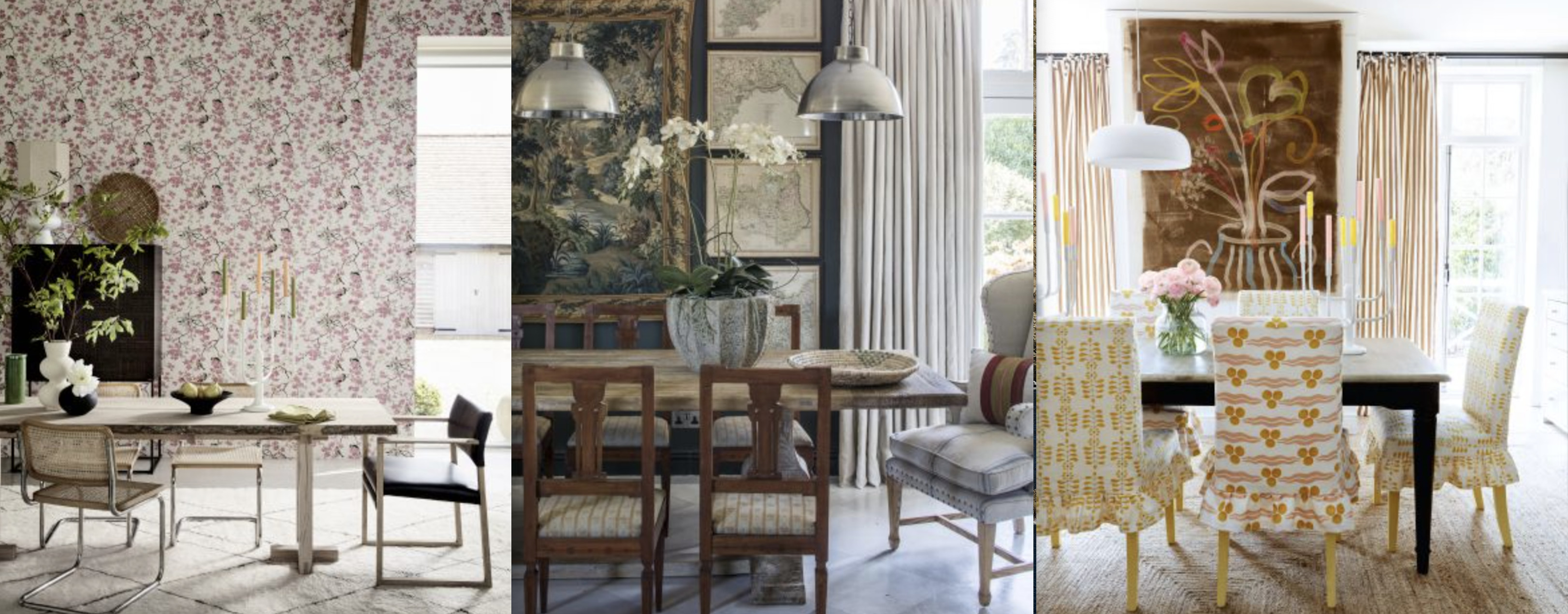
- 1. Indulge in darker colors
- 2. Be bold with wallpaper
- 3. Make the room sparkle with a mirror
- 4. Fill a formal dining room with classic paneling
- 5. Add glimmer with gloss walls
- 6. Use curtains to keep it cozy
- 7. Use light colors to take you from day to night
- 8. Engage your guests with artwork
- 9. Transport guests with a scenic wallcovering
- 10. Storage can double up as decor
- 11. Hang a tapestry

Dining room walls are so key to this practical space. The floor needs to do all the hard work, being filled with all the pieces of furniture that are needed for a dining room to function, but the walls? That's where you can bring in the style and the decor. It's where you can add color, pattern and character to a room that, elsewhere, needs to be incredibly functional.
But despite being practical areas, dining rooms are also an opportunity to be bolder in your decorating style. Unlike more lived-in rooms like kitchens or living rooms, dining rooms are often used for occasions, and as Cindy Rinfret, interior designer and founder of Rinfret Ltd explains, ‘Dining rooms should be the jewelry in the house. It’s a special place where people gather, and they want to be romanced. It's important not to overlook it as a special ‘event’ in your home. We always go with bolder colors and special finishes for dining rooms.’
So with that in mind, how should you decorate dining room walls? We asked interior designers for their top wall decor ideas to suit all styles.
11 dining room wall ideas to add color, pattern and character
From captivating wall murals to mirrors that will leave a twinkle in your guests’ eyes, we’ve found some stunning inspiration for your entertaining space.
1. Indulge in darker colors
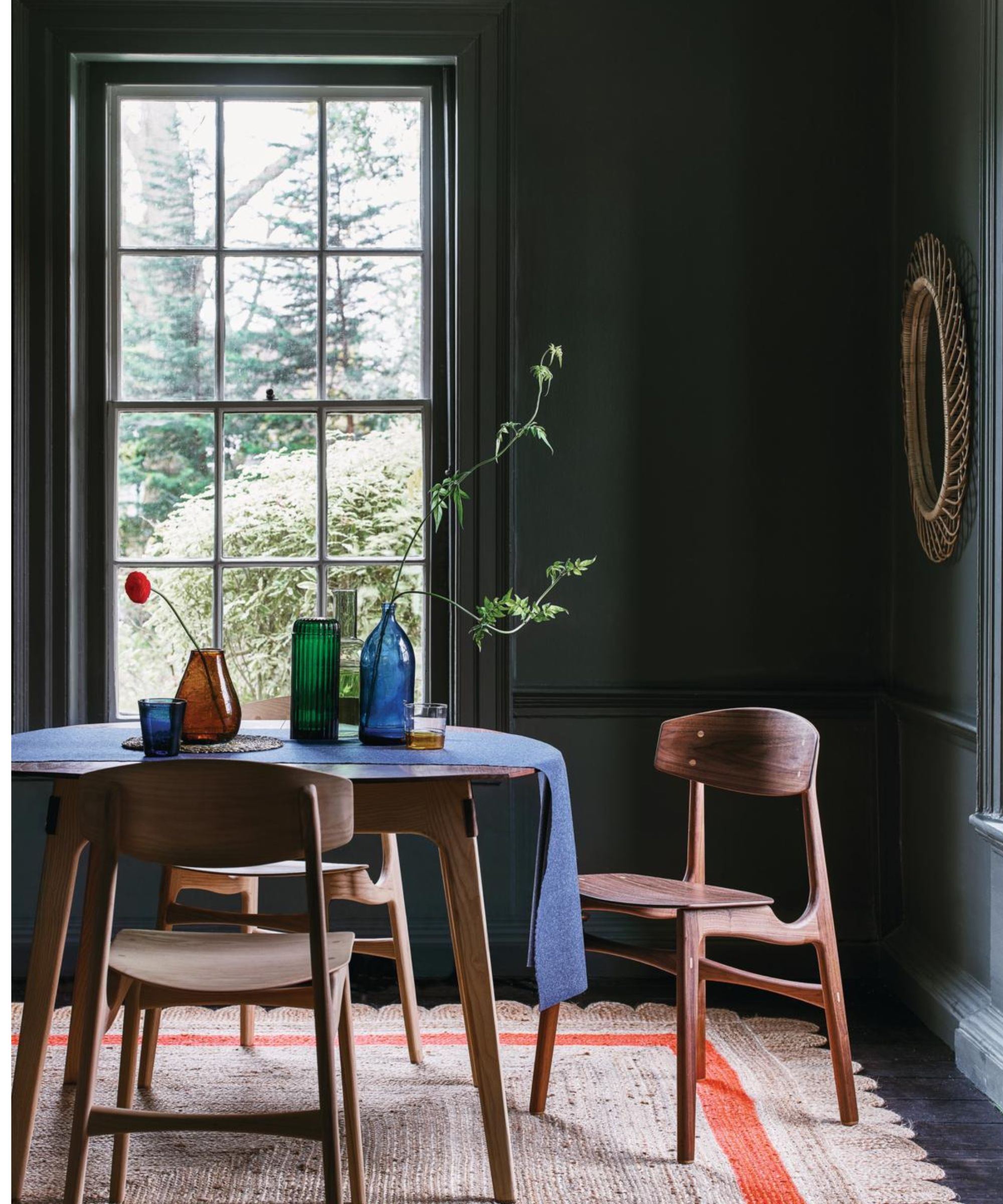
‘Before selecting the paint for your space, consider how the color will influence your mood, it’s so important to love the colors that surround you,’ says Helen Shaw, Director for Benjamin Moore. If you’re planning paint for your small dining room, consider darker tones for drama.
‘Cozy snugs, intimate dining rooms, and pint-sized rooms can lend themselves to a strong color palette, especially when they don’t benefit from a huge amount of natural light,’ explains Helen. ‘Dousing the rooms from floor to ceiling in rich colors can look particularly striking and a real benefit of a north-facing room is that you can play with light sources to create a certain mood and ambiance.’

Helen Shaw is a color expert and Director of Marketing (International) at Benjamin Moore. Helen and her husband Craig were also founders of Shaw Paints, acquired by Benjamin Moore in 2020.
2. Be bold with wallpaper
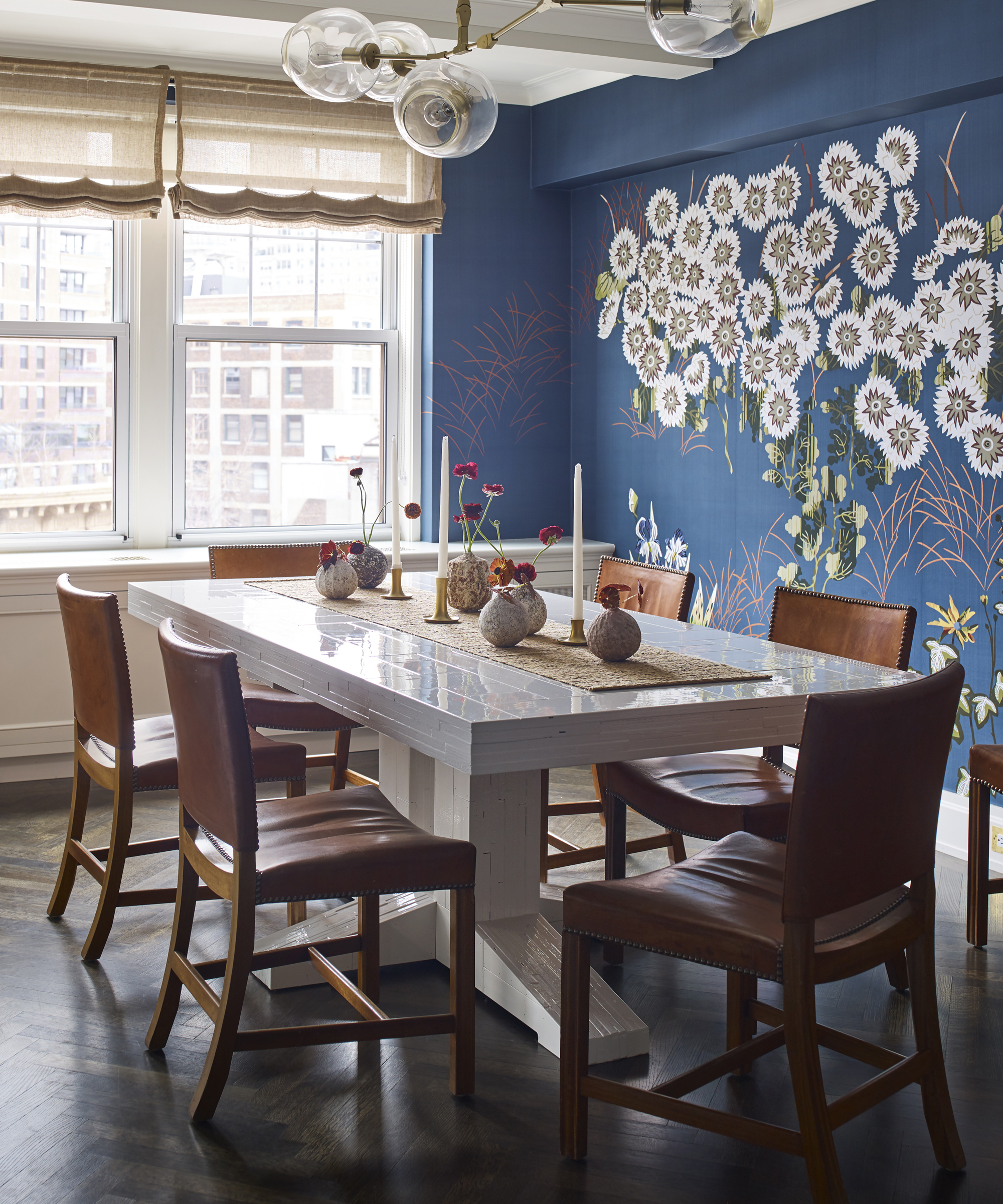
If you’re looking to add visual detail into the room, don’t leave it all down to your dining table decor. Take the floral patterns and colored accents to the walls too.
Design expertise in your inbox – from inspiring decorating ideas and beautiful celebrity homes to practical gardening advice and shopping round-ups.
‘Wallpaper works very well in dining spaces, whether you opt for something plain with lots of texture like grasscloth, or a detailed trailing design if you have good ceiling height,’ says interior designer Birdie Fortescue. ‘De Gournay’s hand-painted Chinoiserie papers are the ultimate wall coverings.’
In this example, furniture expert Christine Retlev chose the Bruyere wallpaper by Fromental for her Manhattan apartment’s dining room, creating a dramatic blue accent wall with natural patterns. ‘Tailored to each individual interior, our designs enhance the beauty of a dining room’s architecture and deliver a sense of excitement and wonder,’ says Lizzie Deshayes, Co-Founder of Fromental.
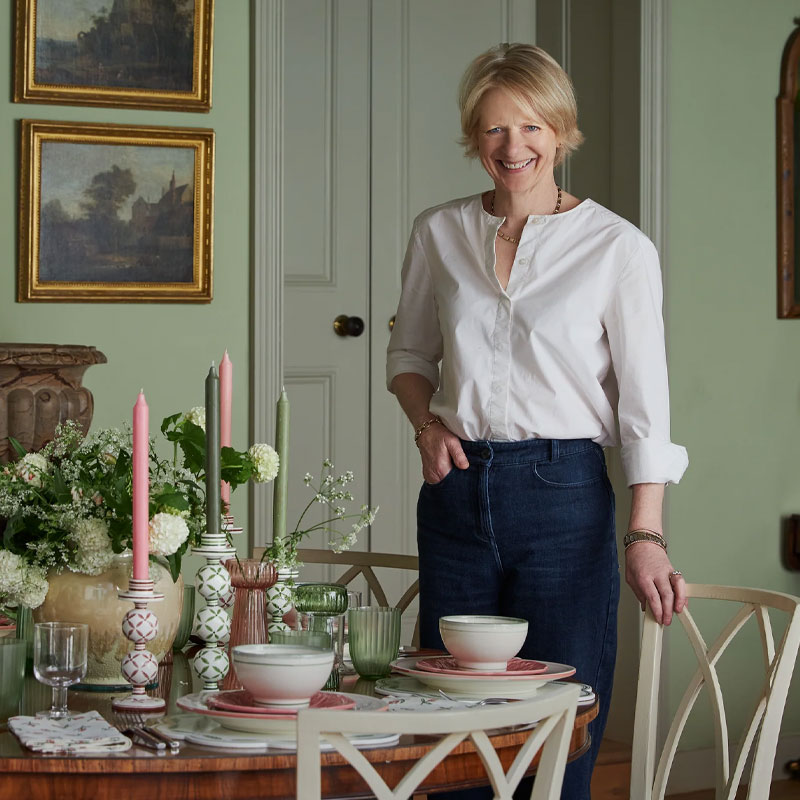
Birdie Fortescue is a UK-based interior designer, and furniture expert, with an eye for combining contemporary and antique furniture.
3. Make the room sparkle with a mirror
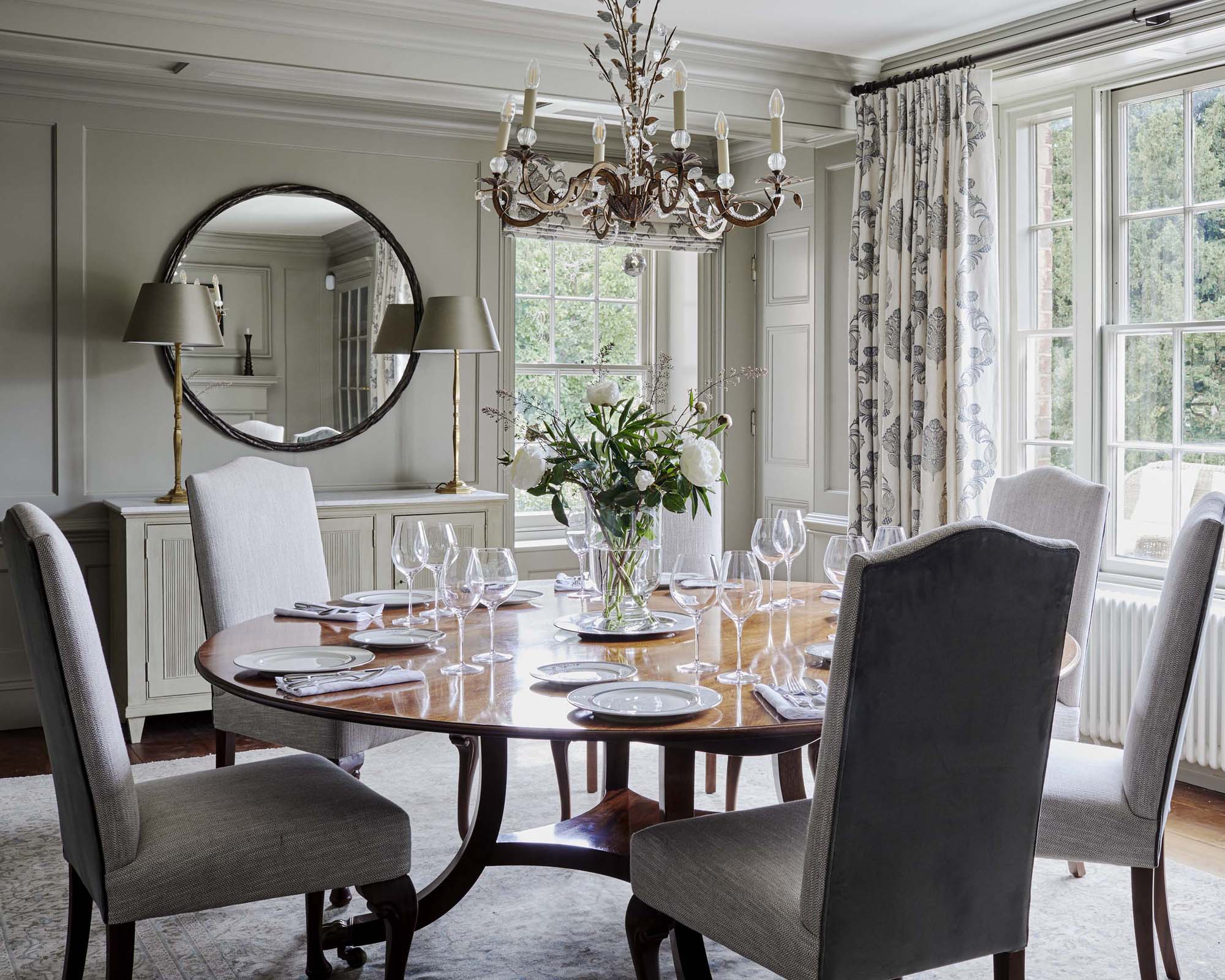
If you’re thinking about dining room lighting consider also how you can make your lighting go further.
‘Decorating with mirrors is a great way to reflect candle/low light,’ says Cindy Rinfret. ‘It adds sparkle to the room and reflects flattering light on your guests.’
‘For a smaller dining room, why not consider installing a round mirror on the wall?,’ suggests Emma Sims-Hilditch, who designed this example. ‘This helps to give the illusion of space, reflecting the light around the room and creating a nice contrast to the sharper lines in the room. Large mirrors covering the walls work well for larger dining spaces, creating an elegant and slightly unusual aesthetic.’
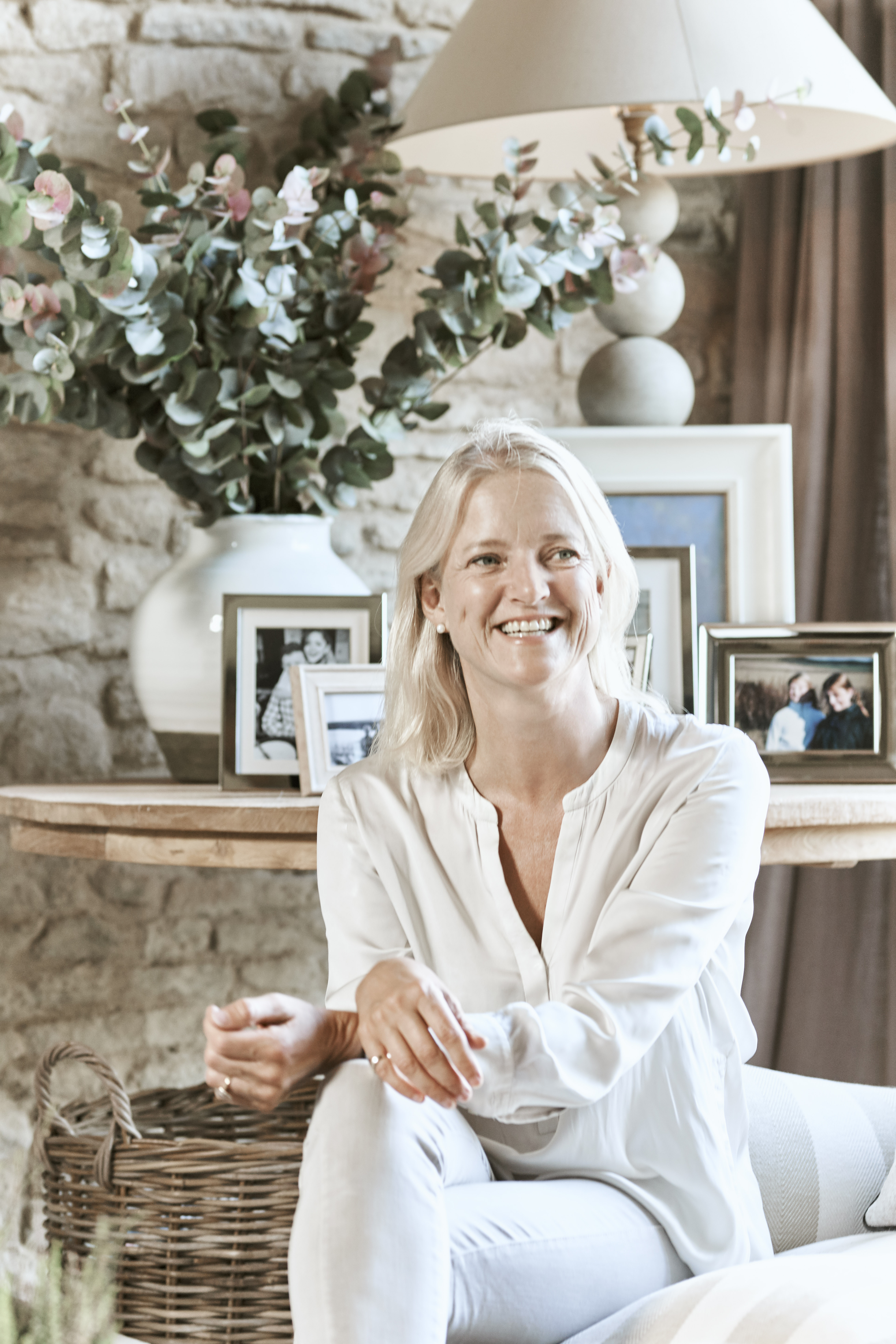
Emma has been in the design world for over 20 years and began making curtains from her mother's table. Since then she has become a design icon, developing the Sims Hilditch brand which has become synonymous with a timeless English style, with a modern and livable reimagining.
4. Fill a formal dining room with classic paneling
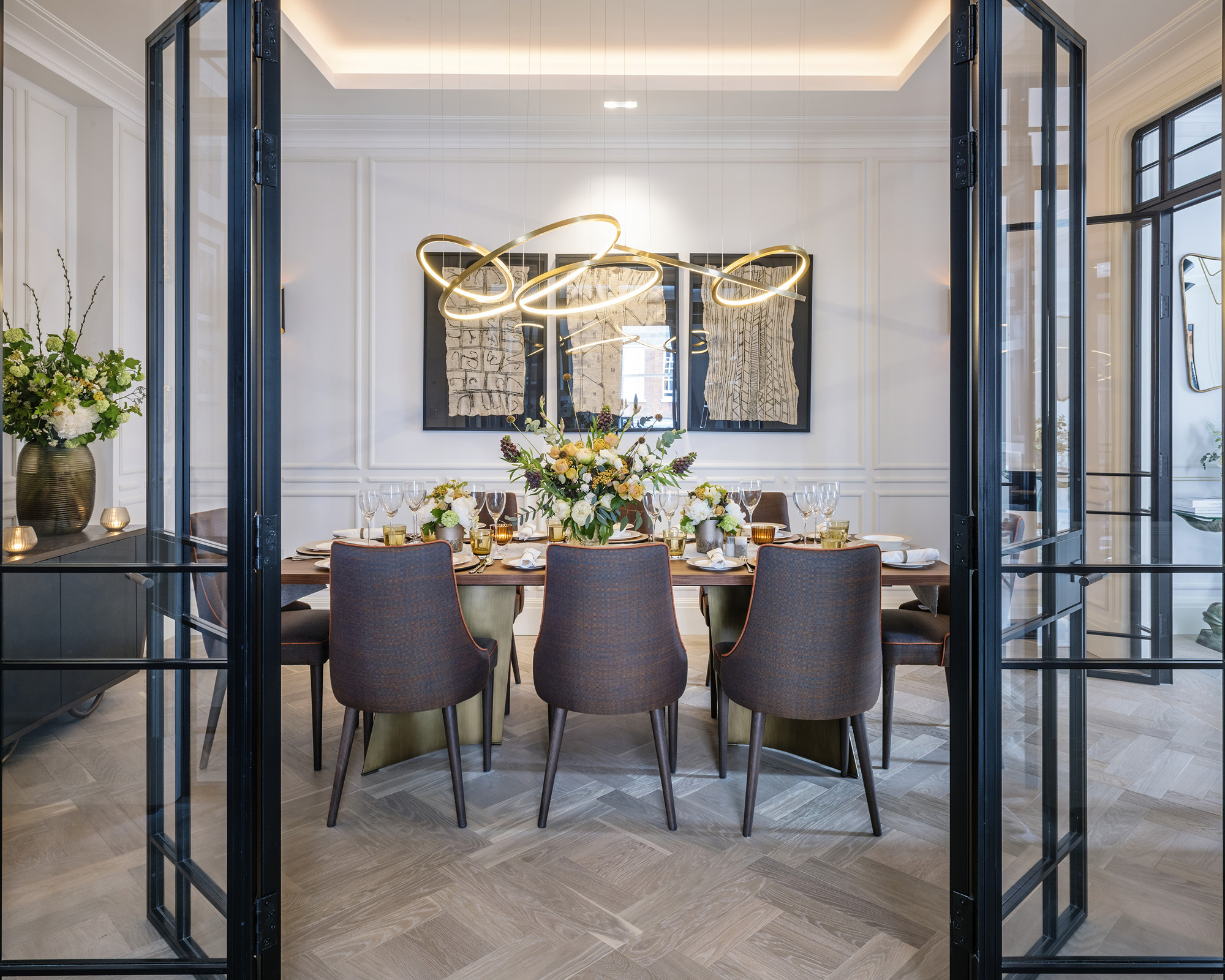
For formal dining rooms with a classic, traditional feel, consider the option of wall panels. ‘I adore paneling and unlike some later additions to buildings I think it works very well even when brand new,’ says Birdie Fortescue. ‘Paneling all the way up to the ceiling gives the illusion of height whilst panels under chair rails are ideal for added interest.’
In this room, subtle white painted paneling has been teamed with contemporary-style lighting, furniture and artwork, to strike a balance between the old and the new.
‘Georgian paneling painted in a timeless shade like Farrow & Ball’s Hardwick White looks great in a formal dining space,’ adds Emma Sims-Hilditch, who did exactly this in the previous example, a design decision chosen to stay ‘in keeping with the home’s rich history.’
5. Add glimmer with gloss walls
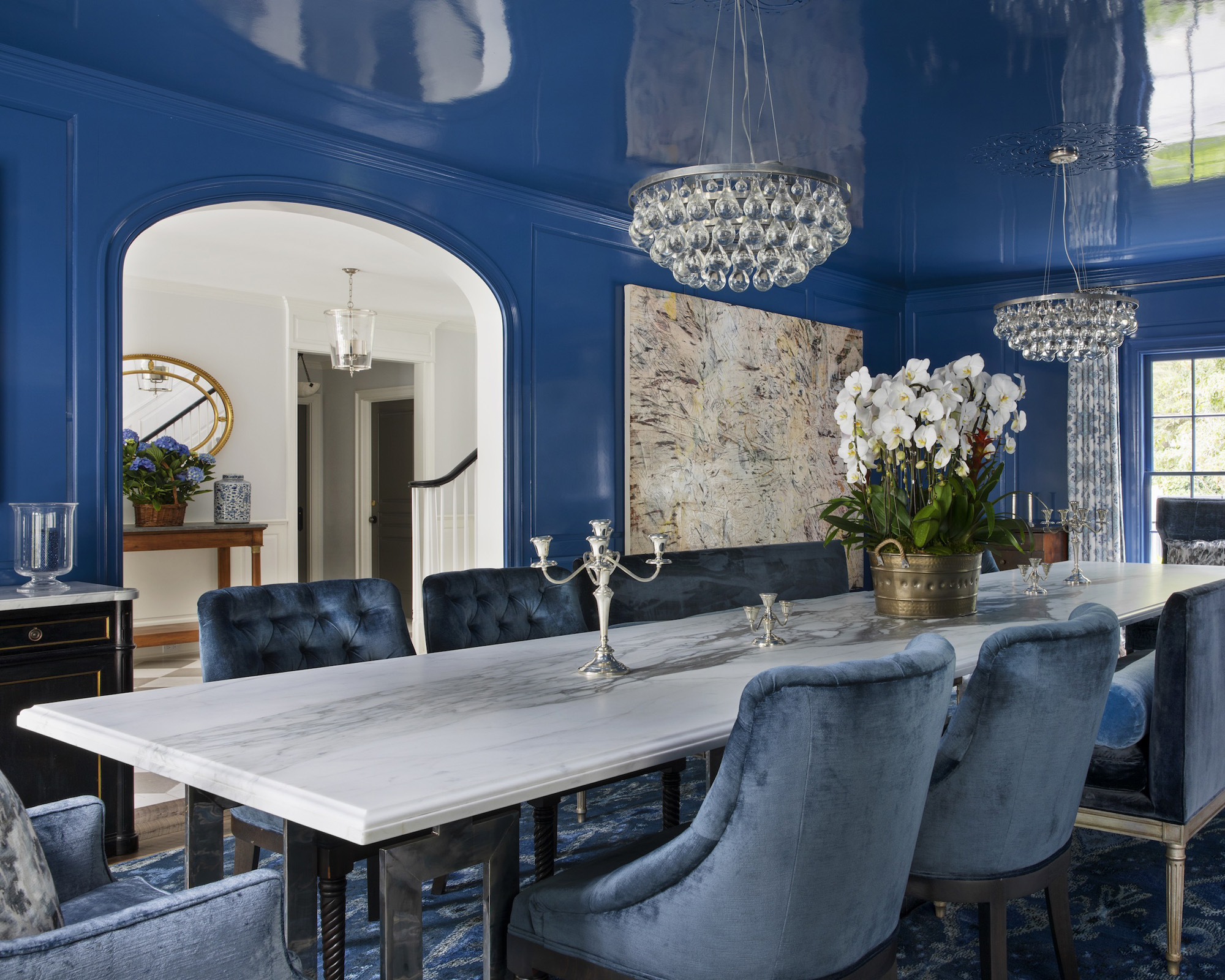
It’s not just your dining room colors you need to think about when choosing paint – the festive nature of the room means you can experiment with alternative finishes too.
‘The dining room is a great space to use a decorative paint finish on the walls as it doesn't get as much traffic as other rooms,’ says Mary Graham, Co-Founder of Salvesen Graham. ‘We love to use a high gloss or lacquer finish which creates the most amazing atmosphere in the evening with the reflection of candlelight. If possible, we use it on the ceiling as well as the walls for the ultimate effect.’
A gloss finish has been chosen for the brilliant blue walls in this dining room by designer Windsor Smith, and the painting of the ceilings give the impression of a glimmering underwater world.
6. Use curtains to keep it cozy
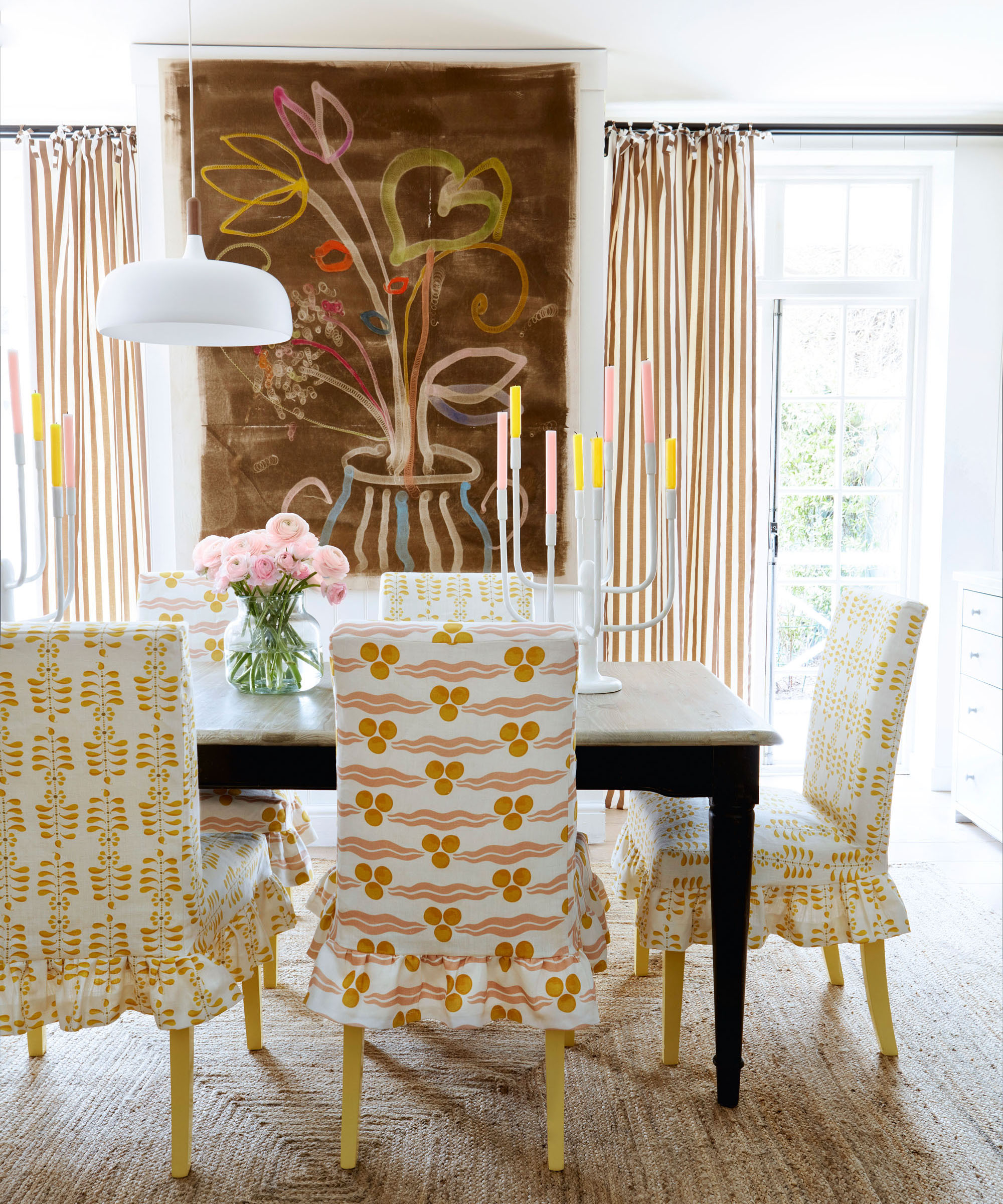
Taking up a large proportion of the space from top to bottom as well as side to side, curtains are always one of the most important wall decor elements to consider.
‘If there are lots of windows, we focus on the window treatments,’ says Cindy Rinfret. Among the dining room wall decor ideas in this room, the dining room curtains allow the room’s bountiful natural light sources to provide during the day, but allow for a cozy, intimate room at night.
7. Use light colors to take you from day to night
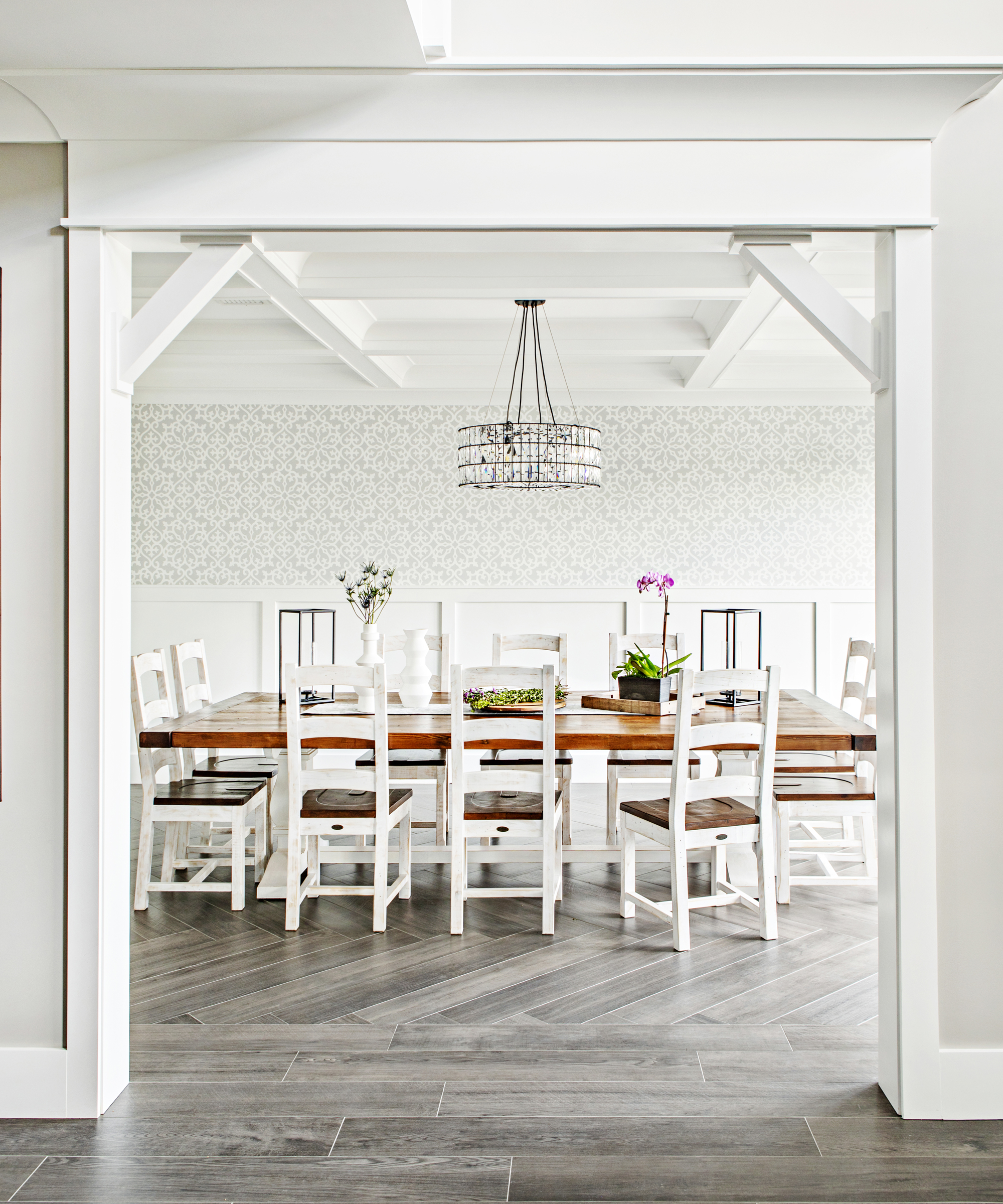
Another way to create a dining room that works for all hours of the day is to keep the decor light and bright – even popular gray dining rooms can verge on off-white.
‘People always have a tendency to use rich dark colors in a dining room, which can look great, but if you want the room to be a bit more flexible then going for something slightly lighter can mean the room is suitable for breakfast and lunch as well as dinner, or could double up as an increasingly needed home office,’ says Mary Graham.
In this design by Marlaina Teich, white woodwork is the star of the show from the beamed ceilings to the lower wall panels, and even in the farmhouse dining chairs. Depth is given to the room by the dove grey pattern on the wallpaper and the natural tones of the wooden dining table.
8. Engage your guests with artwork

‘Decorating with artwork is important in a dining room as people are sitting for lengths of time,’ says Cindy Rinfret. ‘It’s a great way to enjoy a special and favorite piece. We build rooms around art, pulling motifs or colors from the work.’
In this home, the owners were keen that their new dining room would showcase part of their expansive art collection. While the abstract style of the pieces works perfectly here with the modern dining room, historic artworks are a great addition to traditional and contemporary spaces.
‘We often encourage our clients to retain existing artwork when redesigning their homes, which works well with their chosen aesthetic,’ says Emma Sims-Hilditch. ‘This might include old family portraits, or antique pieces which have been in their family for years. These are a wonderful addition to a dining room wall, adding character and gravitas to the space.’
9. Transport guests with a scenic wallcovering
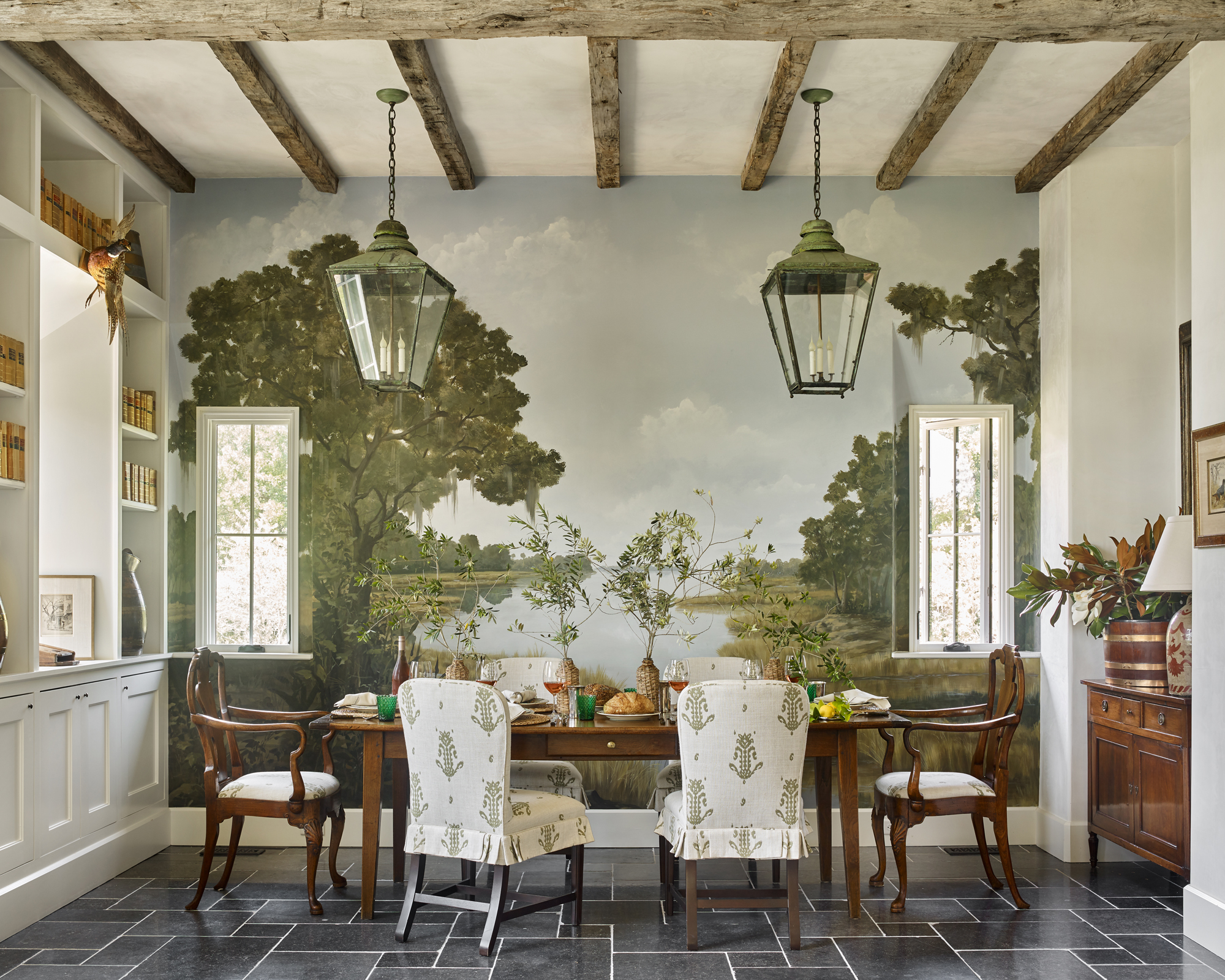
A dining room wallpaper may inject the visual interest you’re looking for, but for sheer escapism, consider wall murals too. ‘A scenic wallcovering, such as Gracie or de Gournay, is a perfect statement as it transports you and your guests. We like to put them in unexpected spaces,’ says Cindy Rinfret.
Wall murals have a place in dining rooms for all the same reasons that artwork does. In this room by interior designer Beth Webb, a custom mural by Bob Christian of Savannah depicts the rolling South Carolina countryside that surrounds the property, and is reminiscent of 18th century pastoral painting.
10. Storage can double up as decor
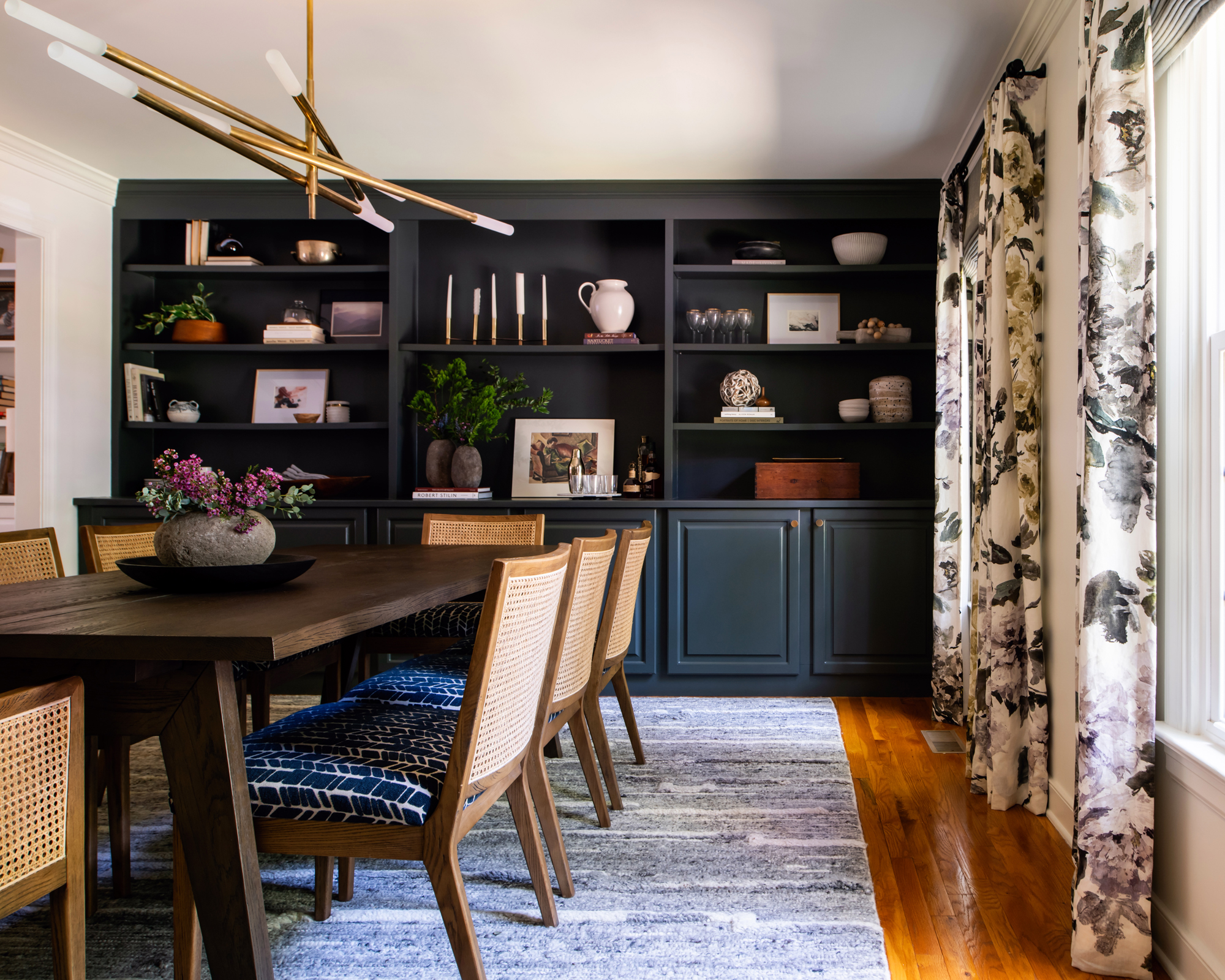
‘Cabinetry and storage is always important in a dining room as you need places to keep and display dinnerware,’ says Cindy. Usually found tucked up against a wall, sideboard decor ideas need to be considered alongside your dining room wall ideas to create balance.
While an individual sideboard can be a statement piece of wall decor in its own right, consider going all out and creating a wall of storage that doubles as decor, like in this dining room by Jamie Ivey. The dark blue built-in unit mixes cabinets and open shelving to allow for discrete storage of day-to-day pieces, and display of favorite items and family photos.
11. Hang a tapestry
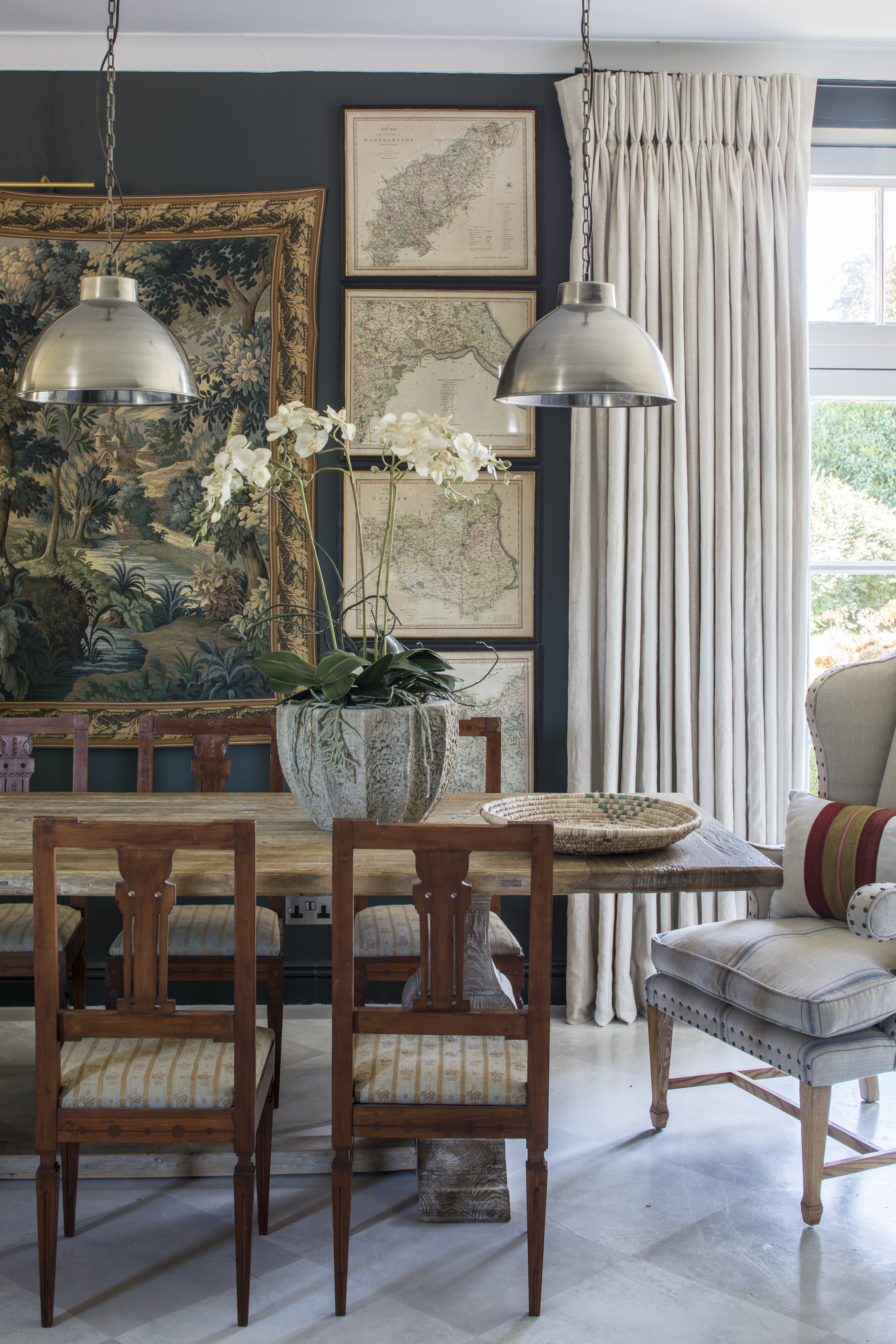
Once used to insulate and decorate in historic houses, tapestries make great dining room wall ideas in modern homes.
'A large tapestry can create a brilliant focal point behind a dining area, while also breaking up the monotony of a wide-reaching blank wall,' says Henriette von Stockhausen of VSP Interiors, who created this dining room above. 'Tapestries also help with noise reduction.'
What do you do with a blank wall in a dining room?
Usually one of the larger rooms of the house and largely populated by low-level furniture, filling the long wall of a dining room can be a daunting task. The first thing you can consider is making the wall itself visually interesting – choosing an asymmetrical wallpaper or a mural is an excellent way to transform it into an accent wall.
Alternatively, fill the wall with art – choosing not one piece, but several, and teaming it with light fittings and mirrors.
‘Art is so often an afterthought in dining rooms and in my opinion there’s no excuse for filling every wall with gloomy family portraits!’ says Fortescue. ‘Series’ of works can be very effective, or pieces selected within a theme. Combine with a well chosen statement mirror or even mirrored panels for lots of interest and personality.’
How do I decorate my dining room?
Dining rooms are a space ready and waiting to display the most bacchanalian corners of your personality. This means that your deepest, darkest, wackiest interior design dreams can be explored here more comfortably than in any other room of the house.
‘Dining rooms often suit dramatic colour and decorative schemes,’ says Fortescue. ‘I always use dark colours in darker rooms and light colours in well lit ones.’
‘Small and large dining rooms can both be equally sexy in a dark color,’ adds Rinfret. ‘Lacquer is always a great choice.’
If you want your dining room to work for both day and night, you’ll need to think carefully about how to balance a color scheme that works for both.
‘Pale shades have light, airy qualities which feel uplifting, neutrals are earthy and help you to feel grounded, whereas deep hues can evoke drama, creativity and confidence,’ says Shaw. ‘So, consider how you will use the room: maybe for a dining room you can enjoy a saturated hue to create a dramatic finish, or create a contrast in an open plan space with dark and light hues of one color. This will allow the room to feel bright in the daylight, but also have cosy and warm attributes when ambiently lit of an evening.’

Ailis started out at British GQ, where a month of work experience turned into 18 months of working on all sorts of projects, writing about everything from motorsport to interiors, and helping to put together the GQ Food & Drink Awards. She then spent three years at the London Evening Standard, covering restaurants and bars. After a period of freelancing, writing about food, drink and homes for publications including Conde Nast Traveller, Luxury London and Departures, she started at Homes & Gardens as a Digital Writer, allowing her to fully indulge her love of good interior design. She is now a fully fledged food PR but still writes for Homes & Gardens as a contributing editor.